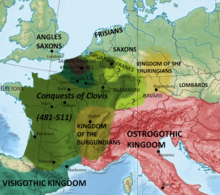
The Saxons, sometimes called the Old Saxons, were the Germanic people of "Old" Saxony which became a Carolingian "stem duchy" in 804, in what is now northern Germany. The political history of the inland Saxons, who were neighbours of the Franks, is unclear until the 8th century and the conflict between their semi-legendary hero Widukind and the Frankish emperor Charlemagne. They do not appear to have been politically united until about that time. Previous Frankish rulers of Austrasia, both Merovingian and Carolingian, fought numerous campaigns against Saxons, both in the west near the Lippe, Ems and Weser, and further east, neighbouring Thuringia and Bohemia. Later medieval sources referred to this eastern area as "North Swabia". Charlemagne conquered all the Saxons after winning the long Saxon Wars (772-804), and forced them to convert to Christianity, annexing Saxony into the Carolingian domain. Under the Carolingian Franks, Saxony became a single duchy, fitting it within the basic political structure of the later Holy Roman Empire. The early rulers of this early Duchy of Saxony expanded their territories, and therefore those of the Holy Roman empire, to the east, at the expense of Slavic-speaking Wends.

Clovis was the first king of the Franks to unite all of the Frankish tribes under one ruler, changing the form of leadership from a group of petty kings to rule by a single king and ensuring that the kingship was passed down to his heirs. He is considered to have been the founder of the Merovingian dynasty, which ruled the Frankish kingdom for the next two centuries. Clovis is important in the historiography of France as "the first king of what would become France".

Childeric I was a Frankish leader in the northern part of imperial Roman Gaul and a member of the Merovingian dynasty, described as a king, both on his Roman-style seal ring, which was buried with him, and in fragmentary later records of his life. He was father of Clovis I, who acquired effective control over all or most Frankish kingdoms, and a significant part of Roman Gaul.
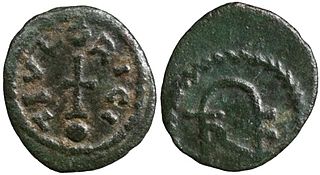
Theuderic I was the Merovingian king of Metz, Rheims, or Austrasia—as it is variously called—from 511 to 534.
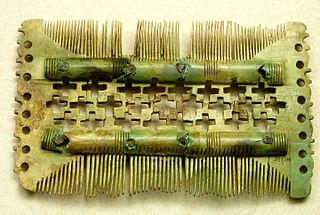
The Thuringii, or Thuringians were a Germanic people who lived in the kingdom of the Thuringians that appeared during the late Migration Period south of the Harz Mountains of central Germania, a region still known today as Thuringia. The Thuringian kingdom came into conflict with the Merovingian Franks, and it later came under their influence and Frankish control as a stem duchy. The name is still used for one of modern Germany's federal states (Bundesländer).

Chlothar I, sometime called "the Old", also anglicised as Clotaire, was a king of the Franks of the Merovingian dynasty and one of the four sons of Clovis I.
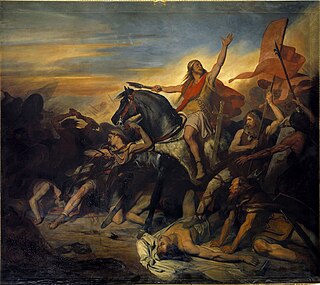
The Battle of Tolbiac was fought between the Franks, who were fighting under Clovis I, and the Alamanni, whose leader is not known. The date of the battle has traditionally been given as 496, though other accounts suggest it may either have been fought earlier, in the 480s or early 490s, or later, in 506. The site of "Tolbiac", or "Tolbiacum", is usually given as Zülpich, North Rhine-Westphalia, about 60 km east of what is now the German-Belgian frontier. The Franks were successful at Tolbiac and established their dominance over the Alamanni.

The Kingdom of the Franks, also known as the Frankish Kingdom, the Frankish Empire or Francia, was the largest post-Roman barbarian kingdom in Western Europe. It was ruled by the Frankish Merovingian and Carolingian dynasties during the Early Middle Ages. Francia was among the last surviving Germanic kingdoms from the Migration Period era.
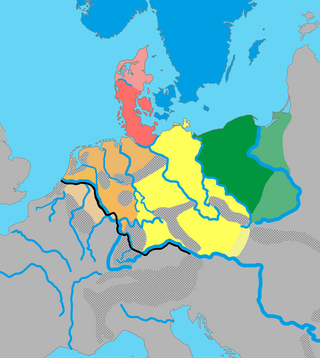
The Istvaeones were a Germanic group of tribes living near the banks of the Rhine during the Roman Empire which reportedly shared a common culture and origin. The Istaevones were contrasted to neighbouring groups, the Ingaevones on the North Sea coast, and the Herminones, living inland of these groups.
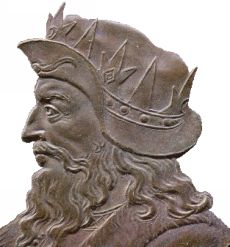
Chlodio, also Clodio, Clodius, Clodion, Cloio or Chlogio, was a Frankish king who attacked and then apparently ruled Roman-inhabited lands around Cambrai and Tournai, near the modern border of Belgium and France. He is known from very few records.

The Salian Franks, also called the Salians, were a northwestern subgroup of the early Franks who appear in the historical record in the fourth and fifth centuries. They lived west of the Lower Rhine in what was then the Roman Empire and today the Netherlands and Belgium.

The Sicambri, also known as the Sugambri or Sicambrians, were a Germanic people who during Roman times lived on the east bank of the river Rhine, in what is now Germany, near the border with the Netherlands. They were first reported by Julius Caesar, who described them as Germanic (Germani), though he did not necessarily define this in terms of language.

The Varini, Warni or Warini were one or more Germanic peoples who originally lived in what is now northeastern Germany, near the Baltic Sea.

The Franks were a western European people during the Roman Empire and Early Middle Ages. They began as a Germanic people who lived near the Lower Rhine, on the northern continental frontier of the empire. They subsequently expanded their power and influence during the Middle Ages, until much of the population of western Europe, particularly in and near France, were commonly described as Franks, for example in the context of their joint efforts during the Crusades starting in the 11th century. This expansion came about because the romanized Frankish dynasties based within the collapsing Western Roman Empire first became the rulers of the whole region between the rivers Loire and Rhine, and then subsequently imposed power over many other post-Roman kingdoms both inside and outside the old empire.
Bertachar was a king of Thuringia from about 510 until about 525, co-ruling with his brothers Hermanfrid and Baderic.

Cambrésis is a former pagus, county and prince-bishopric of the medieval Holy Roman Empire that was annexed to the Kingdom of France in 1679. It is now regarded as one of the "natural regions" of France, and roughly equivalent to the Arrondissement of Cambrai in department Nord. The capital of Cambrésis was Cambrai. Originally ruled by a dynasty of counts, Cambrésis became a prince-bishopric in 1007, comparable to the Prince-Bishopric of Liège and the Prince-Bishopric of Utrecht. It encompassed the territory in which the bishop of Cambrai had secular authority.
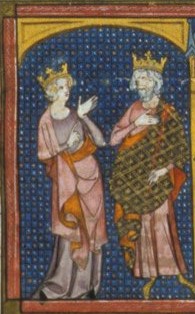
Basina or Basine was remembered as a queen of Thuringia in the middle of the fifth century, by much later authors such as especially Gregory of Tours. However, because Gregory described her family's kingdom of Thuringia as being on the Gaulish or western side of the river Rhine, it is sometimes thought to be the Civitas Tungrorum, which is now Belgium.
Bisinus was the king of Thuringia in the 5th century AD or around 500. He is the earliest historically attested ruler of the Thuringians. Almost nothing more about him can be said with certainty, including whether all the variations on his name in the sources refer to one or two different persons. His name is given as Bysinus, Bessinus or Bissinus in Frankish sources, and as Pissa, Pisen, Fisud or Fisut in Lombard ones.
Ragnachar or Ragnarius was a Frankish petty king (regulus) who ruled from Cambrai. According to Gregory of Tours, Ragnachar "was so unrestrained in his wantonness that he scarcely had mercy for his own near relatives".
Dispargum could refer to either the city of Duisburg on the Rhine, or the village of Duisburg near Brussels, or the city of Diest.
